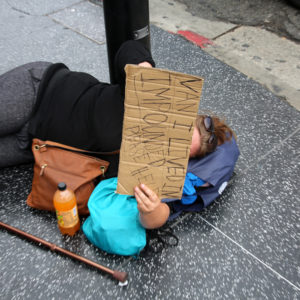According to the U.S. Department of Housing and Urban Development (HUD), California had about 130,000 people without a home in 2018.
Oddly, Gavin Newsom, California’s governor and former San Francisco Mayor, laid the homeless problem squarely at the feet of… Texas.
PolitiFact rated Gov. Newsom’s claim as “Pants on Fire” and “ridiculous.”
So, what is the nature of California’s growing ranks of the homeless?
Some blame can be placed on California policies that make the state a difficult place in which to build new homes. Restrictive zoning, development fees, and environmental regulations—including new greenhouse gas reduction considerations—all act to make homes in California from 40 percent to 60 percent more costly than they need to be.
California’s unaffordable housing likely contributes to the homelessness of between 20 to 30 percent of its homeless population, about half of whom—21,000 people—are in families.
But about 69 percent of California’s homeless population—almost 90,000 people—are “unsheltered” individuals, including almost 10,000 unaccompanied youth. HUD defines unsheltered people as people living on the street, in parks, or in abandoned buildings. Nationwide about 35 percent of homeless are unsheltered. In fact, California lays claim to having 49 percent of the nation’s unsheltered individuals. The people living in California’s flood channels, forests, and freeway easements are largely people so afflicted with drug addiction and mental illness that they either choose not to seek shelter or would be denied admittance.
The growth of America’s legions of unsheltered in Los Angeles, San Francisco, San Diego and north to Seattle—and increasingly in places like Austin, Texas—can be largely traced to a few well-intentioned but disastrous policies.
First, the move to deinstitutionalize people held in state mental facilities in the 1960s and 70s after drug therapy proved to be more effective and humane than prior methods in treating severe mental illness. Around 1955, the nation had more than 550,000 people in mental institutions. By 1994, that number had declined to about 50,000 patients, most of whom occupied psychiatric beds in general hospitals.
The challenge is not an easy one. As Americans, we cherish our liberty. We are rightly loath to deny freedom to persons who can live on their own, if they take their medicine.
But many people don’t. They end up losing their jobs, alienating their families, and living on the streets and in our jails—and, in many cases, self-medicating with illegal drugs.
Nowhere is this more apparent than in California.
There, in 2011, a federal lawsuit accusing California of operating an overcrowded prison system led to the state reducing its prison population by 43,000, shifting most of the inmates to county jails which then, predictably, led to local sheriffs releasing the less-dangerous criminals prematurely back into society.
Soon thereafter, two ballot propositions were passed in 2014 and 2016 that downgraded dozens of theft and drug offenses to misdemeanors, and redefined some felonies from violent to nonviolent. This further depopulated the state’s prisons and jails while also causing the drug court system in many counties to lose their effectiveness, as those arrested for drug offenses no longer feared the consequences—time in jail—of not participating in an addiction treatment program.
Still, California and federal officials continue to hew to the notion that housing is the sole solution to this mental health and drug addiction problem. HUD, for example, continues to maintain an Obama-era policy that prohibits the requirement of sobriety or accountability in the homeless housing it funds, thus placing thousands of addicts—who may be trying to recover—into a counterproductive environment where drug usage is common.
Lastly, the soaring street population threatens a larger public health crisis, as unsanitary conditions worsen. This, coupled with an environmentally-woke reluctance to use proven rodenticides, has resulted an explosion of the rat population. Rats carry fleas—and these fleas carry disease, with typhus spreading in California cities while some public health experts openly worry about an outbreak of the far more deadly bubonic plague, or “Black Death” as it was known in the Middle Ages.
Preventing a serious epidemic while tackling the most difficult of the homeless problem will take a measure of political will that California, and many of its large urban centers, have yet to display.

